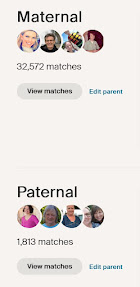Just as I was about to re-introduce myself to the genealogy terms used in Polish records, what should pop up on the research horizon but a Bright Shiny Object. The genea-blogging world is a-buzz with comments on Ancestry.com's update to their DNA results page, a beta version of their "By Parent" option. Now, without having to test a parent, Ancestry has the ability to accurately predict which of our DNA matches align with a specific parent.
Of course, having a database exceeding twenty two million people, AncestryDNA has the resources to experiment with split up our matches by each side of our family. The capability followed on the heels of the company's development, recently released, of what they call SideView™ Technology. Extending the techniques used earlier this year to isolate ethnicity results for "Parent One" versus "Parent Two," Ancestry has now applied that concept to sort through their customers' DNA matches.
There are basically four sets of results. The first—straightforward enough—is a grouping of those matches appearing to connect with others from that same "Parent One" designation used during Ancestry's SideView™ Technology project. The second group—if you guessed, you're on to something here—is DNA matches aligning with "Parent Two." A third grouping, seen mostly by those who either have a history of endogamy in their tree, or have siblings, children, or grandchildren in their matches, is matches who share DNA with both sides of the test taker's family. A fourth group represents those matches for which not enough information could be gleaned to determine parental side—or newer matches arriving after the periodically conducted process has been completed.
For those of us with voracious appetites to learn every last thing we can about this new process, there are ample resources for learning how this development works. Diahan Southard of Your DNA Guide gives an overview, written in her crystal clear teaching style for her company's blog. Leah Larkin of The DNA Geek provides diagrams to help illuminate the science behind Ancestry's latest development. New Zealand's Fiona Brooker is part of this bloggers' update as AncestryDNA expands their worldwide reach, and provides her own observations. There will surely be more blog posts to come.
Of course, I wasted no time in seeing what became of my own thousands of DNA matches at Ancestry.com. Since I've spent the past eight years chipping away at all those mystery matches, I have already used Ancestry's tools to identify maternal versus paternal sides for many of them. When I pulled up the results after this latest technology launch, though, I spotted a detail germane to this month's research goal. Perhaps this will visually demonstrate my uphill battle in discovering more about my paternal grandparents' roots.
My hope had been to find some DNA matches who could lead me to more information on my Polish roots. While the number of DNA matches shown in these results likely includes everything down to the near-dubious level of eight centiMorgans, it is obvious that the split between maternal and paternal matches is heavily weighted toward my colonial-roots mother's side of the family tree. Having 32,572 DNA matches to work with ups the odds of discovering another family member willing to collaborate on a research question. Certainly the possibilities are greater with a number like that than, say, 1,813 matches.
I had wondered whether this lopsidedness truly was an anomaly, so I took a peek at my husband's DNA readout. While his also is skewed toward his maternal side—she of the "endogamy lite" family history—the comparison was much closer than my own lopsided ratio. Perhaps some descendants have more of a proclivity to test than others. Who knows? That just reinforces the observation I've already made: you can't have a DNA match with a distant family member until someone else out there decides to test.

No comments:
Post a Comment